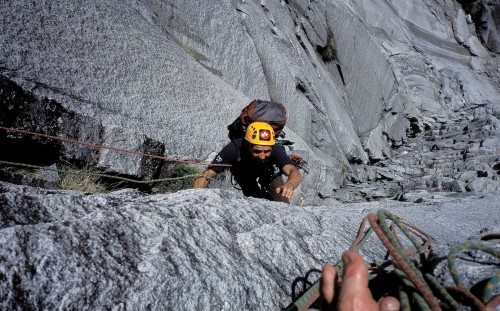
Our main target during this expedition was to climb a classical route on Arco Iris Wall in Cochamo Valley. We were the first Polish team in this region, consequently the expedition was more like an exploration. After two days of transport from amazingly located Cochamo to the camp near Cochamo chalet, we started to climb on the Pared Seca wall, on which there are some short, sport routes - we had there fun for 2 days. Later we chose Brasilian route - Alendelaca on Trinidad Sur - 400 meters; however, after having climbed 3 pitches the heavy rain washed us away.


Two days later we came back on the same route, unfortunately difficulties at the level of 7b stopped us after another 3 pitches and, as we didn't want to rape the wall, we decided to give up and go down. Before that we climbed a pitch 6c+ - in RP style, however. That's because we found the route wet and covered with lichens.
Another 2 days passed and we started climbing on the Gorilla wall, where we wanted to make a new route. In the end, it came out that we are doing another ascent of some old line/attempt. At the beginning we climbed in a classic style and later, from the place where our predecessors finished their job, our hard work began, because cracks were full of weed and flowing water. At that time we went for more of our equipment.
We started again after a day of rest and for the whole time we were fighting with flourishing greenery. Later there was the most amazing crack placed in the roof I've ever made. Finally, we stuck in the darkness, as a day was ending. After a very uncomfortable but fortunately warm bivouac, we moved on in the moonlight. At first there was a classic A0 with cracks covered with weed. Later we started a very psychological aid climbing in something what was supposed to be a crag and turned out to be more like a flared crag or a gutter. We didn't manage to climb this part of the route. When the attempt finished with a fall (yet not a screamer) we decided to withdraw. Above us we had 30 maybe 50 meters of a slab without a possibility to belay. In fact the slab wasn't quite vertical one, but it would be necessary to use bolts in order to make it.
After having a rest, we transported our equipment to the Barrancas Pas. Having spent a night there, we went down without sleeping bags and cooking equipment, through almost a vertical forest to a valley. About 2 p.m. we started climbing, and at the very beginning of the route we had to go through parts of the wall with difficulties reaching 7a. That day we finished work at dusk. After "quite" cold and uncomfortable bivouac we climbed all day long. Before reaching a summit and its top snow field, we had to climb another two pitches 6b+ and 6c. Exactly at a sunset we reached the summit. For the next three hours we were going down to our camp. East wall El Monstruo (that's the name used by climbers in Cochamo) is 1000 meters high and has one particular weak place - a corner which reshapes above into a crack/chimney. This characteristic point gave a route its name The Great Crack (La Gran Raja). The route consists of 22 pitches and has difficulties up to 7a (climbed in OS style). Length - 1100 meters plus 200 meters of a snow ridge.
Except El Mansturo in the company of Justin Griffin from USA we made an ascent of Bienvienidos a mi insomnio on Trinidad Norte (920 meters, 6c. OS). Moreover, but this time in 2-men team, we climbed El pesto viene, el hombre se va... on Trinidad Sur (6c+ A1). Unfortunately, this route had a few pitches covered with water, that is why we had to use aid climbing on one of these pitches. We managed to climb another one on A0 section - graded as 6c+.
The last weekend of our stay in Cochamo was unfortunately rainy, and we had to give up our plans.
Cochamo Valley is located in Chile, in northern Patagonia, near the city called Puerto Montt. The weather in Cochamo is like in the summer and this is the reason for which the valley is often compared to Yosemite. In the valley there are five 1000 meters high walls and plenty of smaller ones, mostly unclimbed. Undoubtedly, there is a great potential of walls where new routes can be freed. Our expedition was possible thanks to financial support of Polish Alpine Association, High Mountains Club in Torun and equipment support offered by Marmot and Lhotse companies.
Links: http://www.climbandmore.com/climbing,32,0,1,mountains.html
http://www.alpinist.com/doc/ALP17/climbing-notes-kowalski
http://www.alpinist.com/doc/ALP07/climbing-note-belczynski
and from Peru